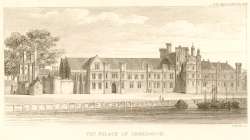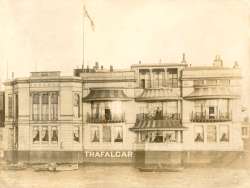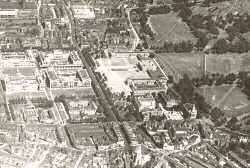History of Central Greenwich
Greenwich, the "�Green trading settlement or harbour" is an ideal place for early habitation on an outcrop of flood plain gravel with the high plateau of Blackheath to the South and the mouth of the Ravensbourne river adjacent. From the time of the Romans, and possibly earlier, settlement of some kind has existed at Greenwich.
From the 10th century when Lewisham, Greenwich, Woolwich, Mottingham and Combe were given to St. Peter�s Abbey in Ghent, written records tell us a little about this early riverside community. In 1012 when their fleet was moored at Greenwich the Danish soldiers brutally murdered Archbishop Alfege whom they had taken hostage the previous year.
Soon after Henry V had severed the connection with Ghent in 1414 Duke Humphrey of Gloucester built himself a fine house on the riverside which was later to become the royal Palace of Placentia, and then Greenwich palace, a favourite home of the Tudor monarchs.
The royal connection strongly influenced the geographical and social development of the town. The palace with its royal park to the south split the community in two: a distinction that still survives as East and West Greenwich.
The slopes leading from Greenwich to Blackheath, and the Heath itself of course, were prized development areas, particularly those plots that overlooked the park or had views of the river.
The riverside area, apart from the area of the palace, was similar to many other Thameside areas: working wharves, a tangle of narrow alleys with many riverside pubs, and neglected housing.
In the nineteenth century fields to the east were developed by Morden College Estates to provide artisan housing. This estate, centred on Pelton Road and Christchurch Way, was designed by the eminent architect George Smith and survives largely intact.
Land to the south west was also developed for housing, and later the country estate of Westcombe and the fields of Eastcombe farm on the Greenwich Peninsula and the slopes of Blackheath were similarly exploited.
However, the central area of Greenwich with its Crown possessions remained intact. Although the palace was abandoned and demolished, Inigo Jones�s Queens House has survived. Built originally for Henrietta Maria in 1616 it became the Naval Asylum School (later the Royal Hospital School) but is now the centre block of the National Maritime Museum.
On the site of Greenwich Palace William and Mary established by royal charter in 1694 the Royal Hospital for Seamen, a grand almshouse for sailors who were no longer able to earn their living at sea. The Hospital closed in 1869 and the buildings were taken over by the Royal Naval College. The buildings are now occupied by the University of Greenwich and Trinity College of Music and the site is now known as the Old Royal Naval College.
Greenwich Park, within which stands the Old Royal Observatory of 1675, is still a very beautiful and popular open space containing many ancient traces such as an extensive Anglo-Saxon burial ground and a piece of tessellated pavement, the remains of the floor of a Romano-British temple, which stood on the high ground on the eastern side of the park.
The devastation of World War II resulted in the redevelopment of some areas of Greenwich but its character remains largely unchanged. It is a much sought after place to live and is a very busy visitor attraction much enhanced by its recent World Heritage Site status.











